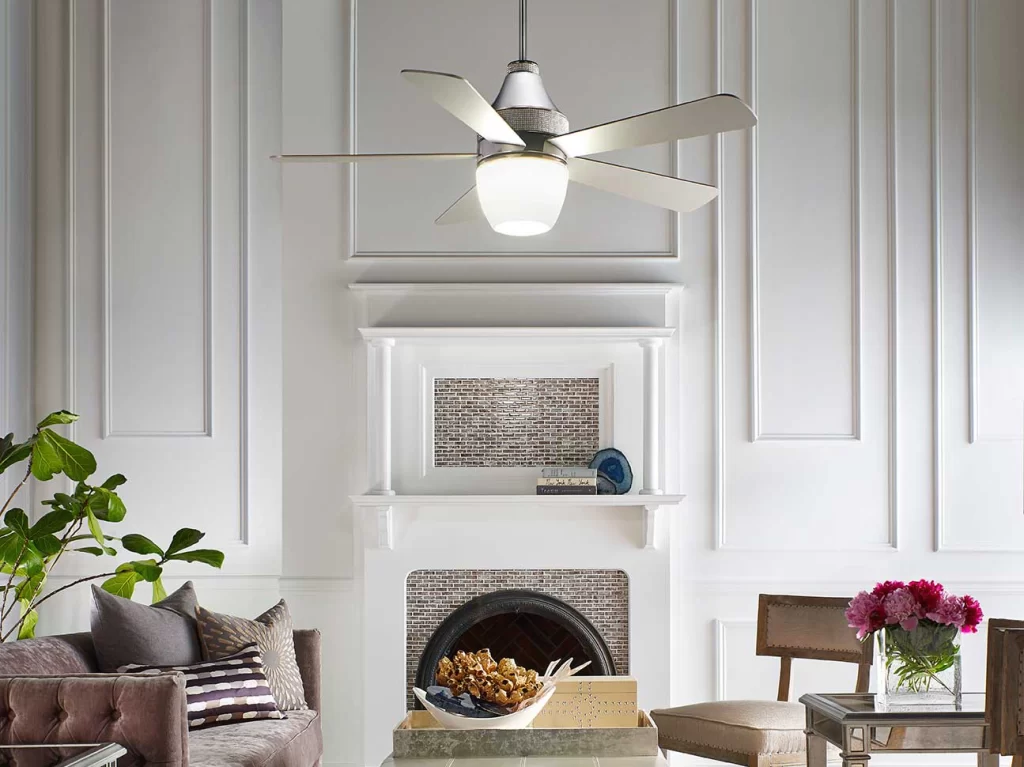Before you begin, make sure you do the following:
If the fan you are replacing has a light source, make sure to turn off the power to the light you’re replacing at the circuit breaker or fuse panel. Once this is done, only then should you remove the light fixture. This can be tested by flipping wall switches or using a circuit tester on the actual light fixture. If there is a pre-existing fixture, remove it and disconnect the wiring. A fan presents a dynamic physical load that is usually much heavier than typical ceiling fixtures that present a static load. Because of these two qualities, if a fan rated box is not already present, the old box will need to be replaced with one that is.
If there is no central light fixture, determine the center of the room, using one of the below techniques:
- Snap diagonal chalk lines from opposite corners of the room. The lines will cross in the exact center of the room (the easier of the two techniques).
- Use a tape measure to measure the walls, and find the halfway points if you really can’t get hold of a chalk line.
Now you’re ready to get started!
Part 1: Install the Junction Box
1. Obtain a fan rated box from home supply or electrical supply store.
It will likely be best to buy the old work (not new construction) style if you do not have access to the ceiling from above. There are two types of old work boxes; one fan rated box is designed to straddle an existing joist; this style can be easier to install, but requires that you find the joist rather than avoid it. The other type has an adjustable bar that expands to span between two joists, it can be a little more involved to install but allows more mounting location choices. Either type works equally well.
2. After determining where to install the fan, assess your ability to get power to it.
See the tips section below for some ideas for a power source. Adjust this location as needed. Next, cut a hole by hand with a sheetrock saw; just large enough to feel around with your fingers to check for potential obstructions for the box. This small opening will make patching easier if it is an unsuitable location.
3. After determining there are no obstructions (i.e. wires, pipes, framing members, etc.)
Trace the fan rated junction box to be installed on the ceiling and cut it out with the sheetrock saw.
4. If installing in a kitchen or dining room, and the existing power source you choose to utilize may be on larger, #12 wire.
Regardless of the location, if your power source is via #12 wires, you must use #12-2 or #12-3 instead of #14-2 or #14-3 where indicated below with ” * ” (A general rule is to never connect different size wires together).
5. Fish a #14-2* or #14-3* cable from a switch box that has BOTH a #14* unswitched 120 volt hot wire AND neutral wire to the fan location.
If your fan has a wireless remote, you may wish to feed directly from a 120 volt outlet plug. Better yet, install a new switch box and run a wire cable from the outlet and fan, wire nut the white wires together and the ground wires (green or bare) together with a wire connector and then connect the two black wires that would connect to the switch together – that would in turn feed the fan. If you ever decide to remove the fan and replace with a light fixture, there will be a wall switch to control it.
6. Use #14-2* cable if you want to either:
A) power the fan (and light if applicable) on and off from one switch. B) power the fan and/or light on and off with an RF remote included with the fan or purchased separately.
7. Use #14-3* if you want to:
C) power the fan independently from the light by two switches in the same box.
8. Running #14-3* provides the ability to do A, B, or C wiring methods mentioned above, and as such provides the greatest flexibility with little added cost.
9. Using appropriate connectors where needed, route the cable into the fan box through the cable entry openings.
10. Secure the fan rated junction box following the manufacturer’s instructions.
All fans vibrate when running. Your mount must be able to withstand this constant stress, this why the National Electrical Code (NEC) mandates the use of fan rated boxes. Many people have been injured due to mount failure prior to this NEC change. Use of fan rated boxes significantly reduces this risk.
11. Determine if a special mount is required.
When mounting to a beamed or angled ceiling, some fans require specific mounts for pitch that may or may not be included with the fan. Most fans however, include a universal mount that will support a fan from “normal” horizontal through most common roof pitch angles. Select the one that best fits the application. Down rod extensions may be added to lower the fan to the desired level.
Part 2: Wire the Fan
1. At the fan box, if you used #14-2 or #12-2 feed:
Attach the wires to the fan by following the standard color coding scheme: switch cable white to fan white, switch cable bare (or green) to fan ground / green, switch cable black to fan black (AND fan blue if present).
2. At the fan box, if you opted for the #14-3 or #12-3 feed:
You will have a switch cable black, red, white and bare (or green). Attach the wires to the fan by connecting switch cable white to fan white, switch cable bare (or green) to fan ground / green, switch cable black to fan black and switch cable red to fan blue.
3. At the switch box, if using two wall switches or controls in the same box:
All grounds (bare & green wires) connect together. The green screw or green wire on each switch should be connected to the ground wire bundle. Wirenut this connection and push towards the back of the box. Connect the power source cable white to fan cable white, wirenut and push towards the back of the box. With switches oriented to read ON and OFF (single pole switches), connect a 6–8 inch (15.2–20.3 cm) black wire power source cable black (or hot) to the bottom screw on each switch. Connect the fan cable red to the top screw on switch #1, and fan cable black to the top screw on switch #2. If all is wired correctly, switch #1 will operate the light & switch #2 will operate the fan. If you want to vary fan speed from the switch box, you should substitute a fan speed controller for switch #2. A dimmer may be used in place of switch #1 to dim the lights.
4. At the switch box, if using one wall switch:
The wiring for the whites and grounds are the same as above. Connect the power source cable black (hot) to the bottom screw of the switch. If you wish to control the light via wall switch: connect the fan cable black to the power source and the fan cable red to the switch, since power is always available to the fan, it can be operated independently of the switch position by the pull chain and the light will operated by the wall switch. Reverse the wire connections to the switch and power source to control the fan by the switch and light by the pull chain.
5. If using a remote, connect the fan black and white wires directly to a power source that is always on (outlet or line side of a switch).
Wire the remote receiver as per the instructions included with it – most likely power source color to remote input color (black to black, white to white) and fan / light color to remote output color (black to black, white to white, blue to blue).
6.Cover each connection with a wire nut.
Keep extra wiring out of the way by pushing it into the electrical box. While working on the fan wiring, use the “wiring hook” that is provided to hang the fan.
Part 3: Assemble the Fan
1. Follow the specific instructions of the manufacturer first.
Most fan blades have a two-pronged attachment, using screws that come through holes in the blades and into the prongs. These need to be drawn up securely, but not so tightly that the threads are damaged or the laminated blade material is crushed.On many fans you’ll find the prongs also need to be mounted to the motor housing. If this is the case, mount them before the prongs are mounted to the blades themselves.
2. Once you start mounting the blade/bracket assemblies to the fan motor, you may need 3 or 4 hands as it can be an awkward job.
3. The manufacturer’s instructions may say otherwise, but if the fan blades are less than a screwdriver’s length away from the ceiling, it may be best to install the blades before hanging the fan.
4. Some fans use a “speed ring” which allows you to assemble the blades on the floor and then attach them to the motor after it has been installed on the ceiling.
To do this:
- Fasten each blade to the speed ring, then attach the assembled ring to the motor unit using rubber grommets and fastening screws.
- Attach the cover over the speed ring and install the decorative cover plate.
Part 4: Wire the Fan
1. At the fan box:
If you used #14-2 or #12-2, attach the wires to the fan by following the standard color coding scheme: switch cable white to fan white, switch cable bare (or green) to fan ground / green, switch cable black to fan black (AND fan blue if present).
Part 5: Hang the Fan
1. To access the wiring that powers the light, loosen the screws that hold the cap on the fan’s switch housing bracket on the bottom.
With the cap removed, you’ll see a bundle of wires. Of these wires, two will be labeled for use with the light kit. One will be white (neutral) and the other will be black, red or blue (hot). Some fans and light kits make use of a plug and jack instead of individual wires.
2. Before wiring the lamp, however, install the adapter ring included with the fan kit bracket.
The adapter serves as a reducing ring for the lamp housing. Attach the adapter ring with the screws provided.
3. Pull the two labeled wires through the adapter ring, lift the lamp and make the wiring connections.
Join the two white wires with a wire connector and the two black, red or blue wires with a wire connector to the remaining labeled wire bracket. If the fan and light have a plug and jack for a connection, simply join them by inserting the plug into the jack. Fasten the light kit to the fan with the screws provided.
4. Power up and test your connection.
Check for wobbling.
Tips
- Most cities require a licensed electrician to perform this work.
- Use only dimmer switches to vary brightness of lights. Do not attempt to dim compact fluorescent lamps unless the lamps are specifically labeled as dimmable.
- Use only speed controllers (never a dimmer) to vary the speed of fan motors.
- Only “fan rated boxes” should be used to support paddle fans. Follow the manufacturer’s directions for installation. Screws must be as tight as possible because loose attachments may cause the fan to wobble and cause excess noise or wear.
- Select the location of the fan by determining the intended use. (Cooling, heat recirculation, etc.) A fan installed for a cooling effect should be installed directly over sitting or activity areas. If using a fan simply for heat recirculation, or to fight condensation, centering the fan is acceptable.
- For special considerations when working with a hugger ceiling fan, consult How to Install a Hugger Ceiling Fan.
- If you are placing the fan in a bedroom or on a high ceiling, make sure it has a wall control, or a remote.
- Follow the manufacturer’s instructions for balancing. Check for balance over the entire speed range of the fan.
- A power source is any constant (can only be shut off at the electrical panel breaker or fuse) 120 volt source consisting of a hot (usually black but sometimes red or blue) and a neutral (almost always white) there may also be a bare or green ground wire, too. The neutral should originate from the same cable (romex, bx, etc.) as the hot. This source does not have to be a new line run from the panel, but may be from an existing outlet or even the line side of a switch where there is at least two cables with a black and white cable in each in the box containing the switch. A meter or tester will assist in determining which is which is the line (unswitched or source) and load (switched) side.
- If the fan is to be placed outdoors, it must be wet-rated or damp-rated.
- Carefully inspect the fan blades prior to securing to the fan. Stacking the blades on top of each other should reveal potential balance problems due to warped wood or plastic blades or bent metal blades and mounting brackets. If any of these conditions are present, it will like cause wobbling and/or noise when running – particularly at higher speeds.
Warnings
- The white wire in romex is not always the neutral wire. If you do not understand the last sentence, call a professional.
- Do not use a power screwdriver to tighten screws — use it to get the screws most of the way in, use hand tools for final tightening to avoid stripping the screws.
- Select a fan for use outdoors that is rated for outdoor or damp locations.
- In nearly all U.S. locations it is illegal to install fixed electrical wiring if you do not have a permit or a licensed electrician.
Source: http://www.wikihow.com/Install-a-Ceiling-Fan






